Ijraset Journal For Research in Applied Science and Engineering Technology
- Home / Ijraset
- On This Page
- Abstract
- Introduction
- Conclusion
- References
- Copyright
An Overview of the Effect of Rising Traffic and Congestion in Bangalore on the Lives of General Public
Authors: Vivek Gupta , Anshul Agrawal, Dheeraj K Madhu, Yash Agrawal, Jeet Bhayani, Sidharth Adhlakha
DOI Link: https://doi.org/10.22214/ijraset.2024.59262
Certificate: View Certificate
Abstract
Bangalore, India\'s Silicon Valley, is experiencing widespread traffic congestion, which has a significant impact on the urban environment of the city. This study looks at the complex effects of traffic congestion on public health, social well-being, economic productivity, and air quality in Bangalore\'s metropolitan environment. By conducting a thorough examination of extant literature and statistics, the research clarifies the adverse consequences of traffic congestion, including elevated levels of air pollution, an increase in traffic accidents, extended travel times, and reduced productivity. The research also looks at possible mitigating measures, such as bettering the infrastructure for public transit, enacting congestion pricing plans, encouraging the use of alternate forms of transportation, and implementing clever urban design techniques. Policymakers can create successful measures to address traffic congestion by having a thorough understanding of the intricate relationship between the two.
Introduction
I. INTRODUCTION
Bangalore, often referred to as the 'Silicon Valley of India,' is a city renowned for its technological prowess, economic vibrancy, and rich cultural diversity. It has witnessed a meteoric rise in population and urbanization over the past few decades, making it one of India's fastest-growing metropolitan areas. However, this rapid growth has brought with it a host of challenges, chief among them being traffic congestion. This research paper aims to delve into the multifaceted effects of traffic congestion on the city of Bangalore, examining how it affects the daily lives of its residents, the environment, and the overall urban landscape.
Traffic congestion in Bangalore has become a ubiquitous and pressing issue that touches the lives of every Bangalorean. The city's narrow roads, inadequate public transportation, and a burgeoning number of vehicles on the road have created a perfect storm of traffic snarls, extended commute times, and frayed nerves. The gridlock not only disrupts daily routines but also poses significant economic consequences. People spend hours in traffic every day, leading to a decrease in productivity, increased stress levels, and a diminished quality of life.
One of the most immediate and palpable effects of traffic congestion in Bangalore is the toll it takes on people's health and well-being. Prolonged exposure to vehicular emissions, noise pollution, and the stress of navigating through congested streets contribute to various health problems, including respiratory issues, hypertension, and mental health concerns. Children and the elderly, in particular, are vulnerable populations that bear the brunt of these adverse health effects.
Furthermore, the environment in Bangalore is not immune to the detrimental impacts of traffic congestion. The city's air quality has plummeted due to vehicular emissions, leading to increased levels of air pollution and its associated health risks. Bangalore's once-lush green cover is dwindling as urban sprawl encroaches upon green spaces and parks. The excessive use of fossil fuels in traffic congestion exacerbates global warming and contributes to climate change, posing long-term threats to the city's sustainability.
In addition to health and environmental concerns, traffic congestion also impacts the city's economy. The snail-paced traffic impedes the swift movement of goods and services, leading to delays in supply chains and increased transportation costs. Businesses suffer from decreased efficiency and increased operational expenses. Moreover, traffic congestion has a negative impact on the city's image as an attractive hub for investments and job opportunities. Potential investors and skilled professionals may think twice before relocating to a city notorious for its traffic woes.The effects of traffic congestion in Bangalore are not limited to the immediate consequences mentioned above. It also influences the social fabric of the city. Commute times have increased so significantly that people spend less time with their families and friends, leading to social isolation. Additionally, the stress and frustration caused by traffic congestion can lead to road rage and accidents, further deteriorating the city's social environment.
II. OBJECTIVE AND SCOPE OF STUDY
This research paper seeks to examine the effects of traffic congestion on Bangalore's economy, social fairness, health, perception among the general public, and vision for the future. By looking at these elements, we hope to develop a thorough knowledge of the difficulties caused by traffic congestion and investigate potential solutions.
- Examining Traffic Congestion: This study paper examines Bangalore's traffic congestion levels as well as its immediate and long-term social impacts. It will examine the factors contributing to traffic congestion, such as growing urbanisation and inadequate infrastructure, and determine how they affect livability.
- Effects on Productivity: This essay will look at how Bangalore's traffic congestion affects workers' levels of productivity. It will examine the effect on commuting to work, travel time delays, and the ensuing stress and annoyance felt by people. It will also look at the financial effects of lower productivity brought on by traffic congestion.
- Environmental Impact: Bangalore traffic's effects on the environment will be examined in this study paper. It will examine how car emissions affect air quality, how they affect people's health, and how the city's environment can be sustained over the long run. We'll also look at other ways to lessen the impact on the environment.
- Quality of Life: This essay will look at how Bangalore's traffic congestion affects people's overall quality of life. It will look into how it affects family time, leisure time, and mental health. The study will take into account the effects on emergency response times as well as public safety.
- Various Solutions: This study article will consider various remedies to lessen Bangalore traffic's detrimental effects on society. It will evaluate the efficacy of currently in place measures including traffic control plans and public transit networks. It will also look into creative solutions like boosting eco-friendly transport options and putting smart traffic systems in place.
- Causes: Rapid urbanization, population expansion, a lack of suitable road infrastructure, and a rise in the number of private vehicle owners are some of the causes of Bangalore's traffic congestion.
- Effects: Bangalore's excessive traffic increases commuter stress levels, travel times, fuel consumption, and air pollution. The productivity, economic expansion, and general quality of life of the city are also impacted.
- Potential Solutions: To reduce traffic congestion, possible solutions include enhancing public transportation networks, such as bus and metro networks, putting in place smart traffic management systems, building new roads and flyovers, encouraging carpooling and ridesharing, and promoting the use of alternative modes of transportation, like cycling and walking.
Buses and the metro are just two of Bangalore's well-developed public transportation options. You may avoid the headache of driving in traffic by using these types of transportation.
Carpooling: To share a ride and lessen the number of vehicles on the road, think about carpooling with friends or coworkers. It is a terrific method to reduce traffic congestion and save time and money.
Timing: If at all possible, try to avoid travelling during busy times. You can avoid the brunt of rush hour traffic by altering your schedule because it tends to be worse in the mornings and evenings.
Explore other paths to get to your destination. Sometimes it is faster to take a slightly longer route where there is less traffic rather than being caught in a traffic congestion on the main roadways.
Keep Up to Date: Utilize apps or websites that offer real-time traffic updates to be updated about the current traffic situation. This might assist you in making better travel plans and avoiding crowded roadways.
???????III. REVIEW OF LITERATURE
Real-world incidents in recent years have starkly illustrated how Bangalore's traffic circumstances affect the corporate lives of the city's professionals. Bangalore's traffic conditions have long been a source of discussion and worry. Here are a few notable instances:
- Lengthy Commuting Distance and Lost Productivity Real-Life Example
In Bangalore, India, in October 2020, a huge downpour caused many trips to take hours when they should have only taken minutes. Due to wet roads and traffic congestion, a drive that would ordinarily take 30 minutes can take several hours.
Impact: These occurrences result in significant production losses. Hours wasted in traffic prevented workers from making it to work on time, attending important meetings, or performing at their best.
2. Disrupted Work-Life Balance:
Example from Real Life: Bangalore's traffic was in the news in December 2019 after a software engineer stated in a widely shared social media post that his daily journey left him with only 10 minutes of quality time with his family each day.
Impact: Situations like this highlight how a person's ability to maintain a healthy work-life balance is hampered by traffic congestion. Lack of personal and family time can lead to more stress, which can have an adverse effect on general health.
3. Job Instability and Employee Attrition
Real-World Example: In 2018, a study by a well-known Indian employment portal revealed that due to the stress of Bangalore's traffic, more than 60% of IT workers were actively looking for work in other locations.
Impact: As professionals, the ongoing battle against traffic congestion may result in higher attrition rates and employment instability.
4. Business Operational Disruptions:
Real-Life Example: Because of significant traffic delays during festivals in 2017, a number of e- commerce businesses had to reschedule or cancel deliveries. Customer discontent and financial losses were caused by the inability to deliver products on time.
Traffic congestion frequently causes operational problems for businesses in Bangalore, which affects supply chains, customer happiness, and overall effectiveness.
5. Sustainability-Related Issues:
Real-Life Example: As environmental awareness spreads throughout the world, businesses in Bangalore are subject to more scrutiny for their location decisions and their involvement in traffic-related pollution.
Impact: Companies may need to modify their sustainability plans and take steps to lessen the environmental harm that traffic congestion causes.
6. The Prolonged Commute:
The lengthy and difficult travel that professionals endure is one of the most obvious repercussions of Bangalore's traffic on business life. This problem is eloquently illustrated by a real-life occurrence. The average commute time in Bangalore has increased to a startling 72 minutes, according to a 2019 survey by Move in Sync, a provider of business mobility solutions. In addition to depleting employees' energy, a long trip also lowers productivity. Employees frequently come to work drained and worried, which sets the stage for a difficult day.
7. Impact on Work-Life Balance:
A person's well-being depends on finding a balance between their personal and professional lives. The traffic in Bangalore, however, frequently upsets this balance. The experience of Anjali, a software engineer who works in the city, serves as a real-world illustration. She frequently finds herself spending hours in traffic, unable to pursue her personal interests or spend meaningful time with her family. The constant traffic may exacerbate stress and fatigue, putting a strain on interpersonal connections and general happiness.
8. Health-Related Issues
The traffic congestion in Bangalore has a detrimental effect on both physical and mental well-being. Research conducted by the Indian Institute of Science in 2020 unveiled alarmingly high levels of air pollution in the city, posing a significant health hazard. This situation has a particularly negative impact on the respiratory health of professionals, leading to ailments like asthma and bronchitis. Furthermore, the daily commute-related stress can contribute to anxiety and depression, further compromising overall health.
9. Economic Ramifications
The repercussions of traffic congestion in Bangalore extend beyond individual commuters to impact corporate finances. A real-life example illustrates this point vividly. A logistics company operating in the city experienced severe disruptions due to traffic jams. Deliveries faced frequent delays, resulting in customer dissatisfaction and financial setbacks. Increased operational costs, including extra fuel expenses and overtime pay for stuck drivers, eroded the company's profits. This case underscores the economic implications of traffic congestion for businesses.
10. Talent Retention Challenges and Attrition: -
The corporate landscape in Bangalore constantly grapples with the challenge of retaining talent, with traffic congestion playing a pivotal role in influencing employee decisions. For instance, a multinational IT company headquartered in Bangalore witnessed an increase in attrition rates.
Employees frequently cited the arduous commute as a primary reason for seeking opportunities elsewhere. The struggle to keep talent can severely impact businesses, affecting their competitiveness and growth prospects.
11. Disruptions to Operations: -
Companies heavily reliant on timely deliveries and transportation of goods bear the brunt of Bangalore's traffic woes. A notable incident occurred in 2021 when a popular e-commerce giant had to contend with operational disruptions due to traffic congestion. Delayed deliveries led to customer complaints and tarnished the company's reputation. Such disruptions underscore the practical challenges businesses encounter while navigating the city's congested roadways.
12. Recruitment Hurdles: -
Traffic conditions in Bangalore can deter potential job candidates from considering positions within the city. An illustrative example is the experience of a multinational consultancy firm that struggled to attract top talent for its Bangalore office. Many candidates were discouraged by the prospect of enduring the city's notorious traffic daily. This highlights the recruitment obstacles faced by companies operating in Bangalore.
13. Strain on Infrastructure: -
The influx of businesses into Bangalore exacerbates traffic congestion, placing immense pressure on the city's infrastructure. A recent development exemplifying this is several major IT companies announcing the establishment of satellite offices in neighboring towns and cities. This decision reflects the growing strain on Bangalore's infrastructure and the necessity of finding alternative solutions to traffic issues.
14. Sustainability Considerations: -
Bangalore's traffic congestion contributes to heightened emissions and environmental degradation. A real-life incident from 2022 involved public criticism of a prominent technology company operating in the city. Activists and environmentalists condemned the company's choice of location and the environmental impact of its employees' daily commutes. This highlights the sustainability concerns that companies encounter when operating in areas plagued by traffic congestion.
In summary, these real-life examples highlight how Bangalore's traffic conditions affect the corporate life of its professionals in various ways, including lost productivity, disrupted work-life balance, attrition, operational disruptions, and sustainability concerns. Addressing these challenges is essential for maintaining a healthy and thriving corporate environment in the city.
IV. RESEARCH METHODOLOGY
Research methodology is the specific procedures or techniques used to identify, select, process, and analyze information about a topic.
The research method used in this paper for the topic ‘Bangalore traffic’s impact on general public’ is both primary and secondary in nature.
Elements of Primary research can be displayed by the use of surveys / google forms to understand the quantitative depth of research. Primary research is also showcased in the form of different observations during the length of research. Secondary research makes use of data that is already existing.
Existing data is summarized and collated to increase the overall effectiveness of the research. For this paper, data was collected from the Internet, which includes research documents,article and studies
V. QUESTIONNAIRE
A. Generic Questions
Q. Name
Q. Age
Q. Which area in Bangalore do you reside?
B. Survey Questions
Q1. Have you ever been a victim of Bangalore traffic?
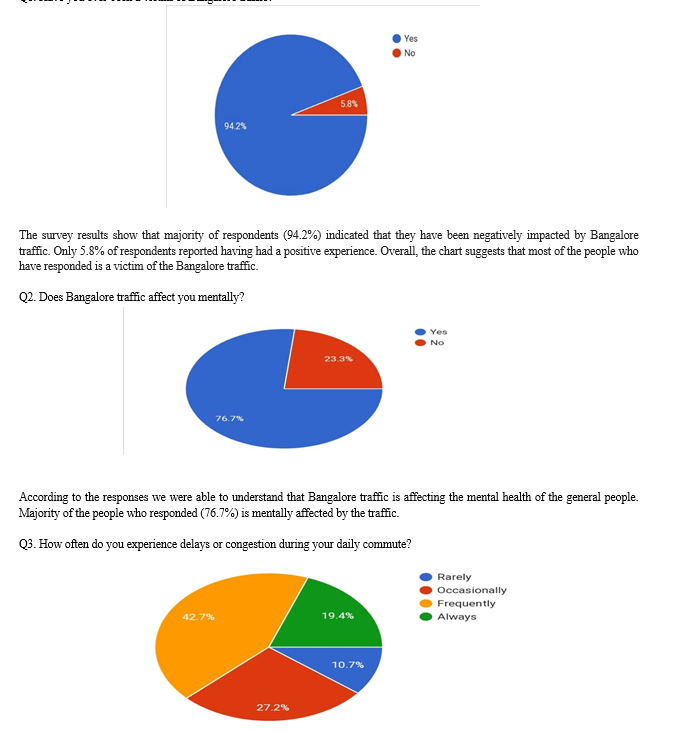
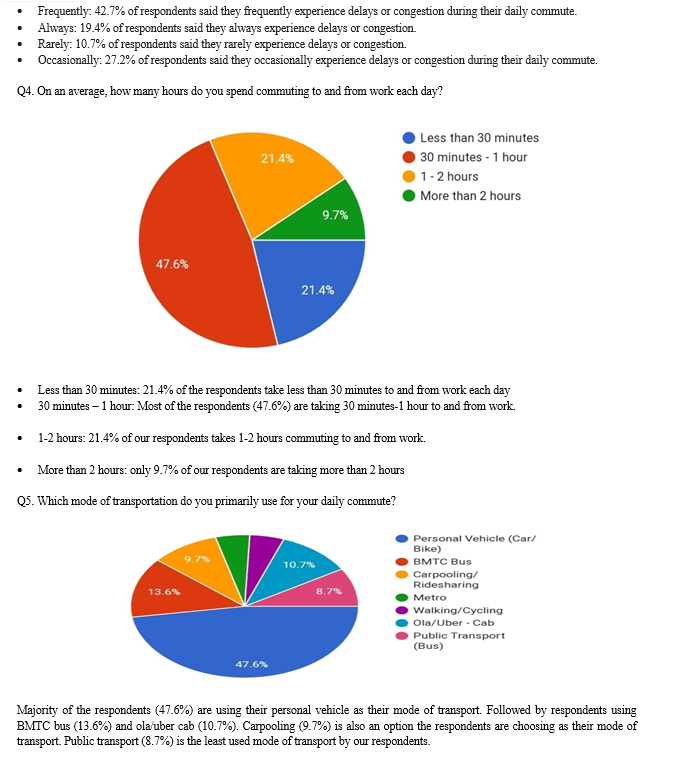
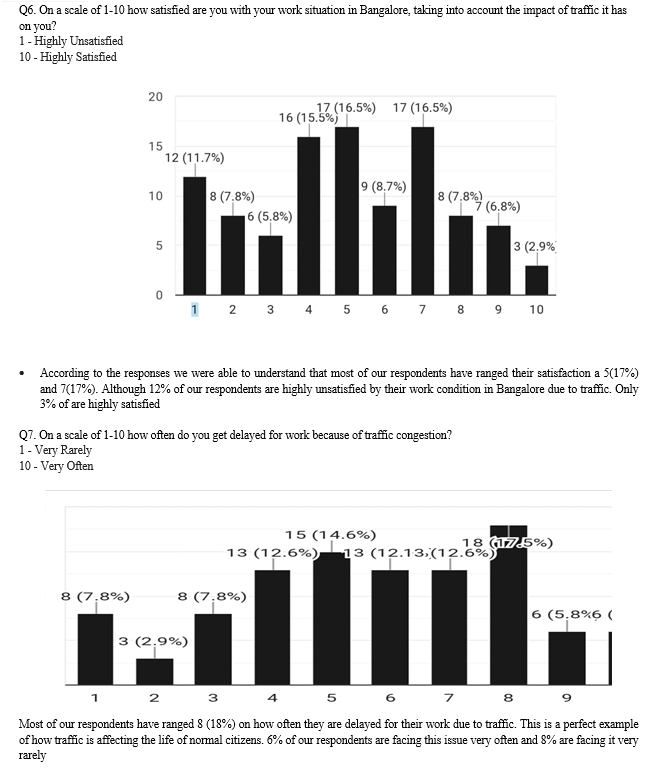
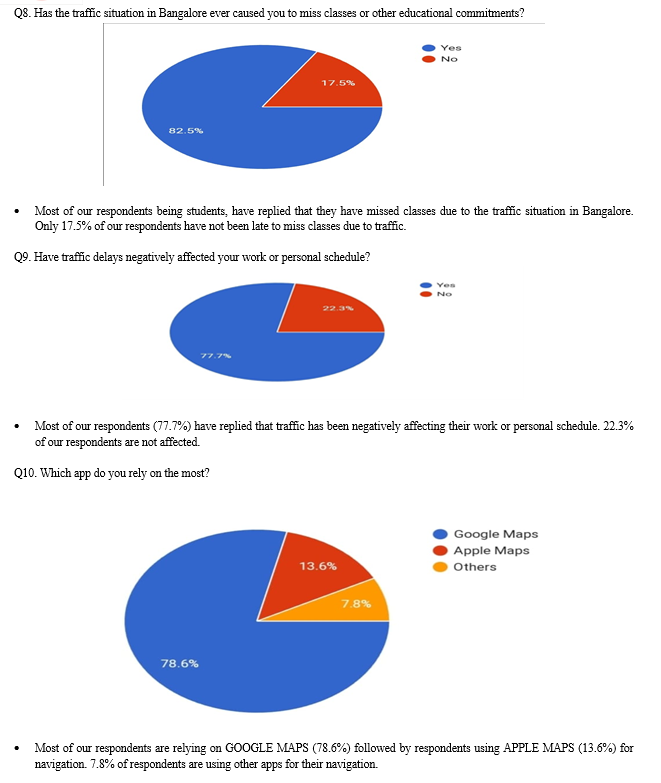
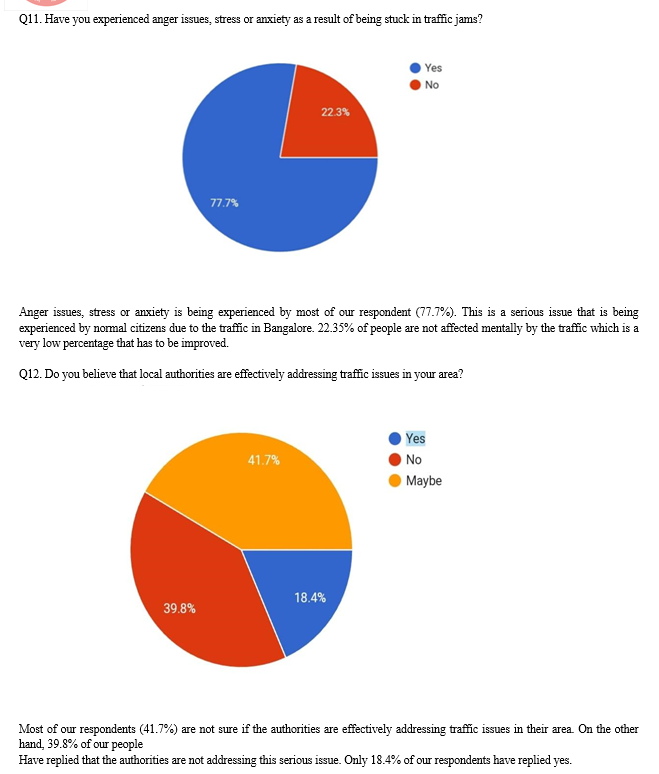


Q19. Are there any specific traffic rules or regulations that we should be aware of in Bangalore?
Yes, as most of the responses said that both the passenger in two weller should wear the helmet.
Q20. Do you recommend any mobile apps or websites for real-time traffic updates in Bangalore? (excluding: Google Maps)?
Yes, as most of the responses said that GPS alert traffic alert should be followed.
VI. LIMITATION
- Sample Size: The study might be limited by the sample size of participants surveyed or observed, potentially affecting the generalisability of the findings to the entire population of Bangalore.
- Time Constraints: The study might have been conducted over a specific time period, which may not capture seasonal variations or long-term trends in traffic patterns and their impacts on the general public.
- Data Accuracy: Reliance on self-reported data or secondary sources for traffic-related information may introduce biases or inaccuracies in the findings.
- Scope of Analysis: The study may focus primarily on the immediate impacts of traffic congestion without delving into broader socio-economic factors or long-term consequences on public health, productivity, and quality of life.
- External Factors: External factors such as infrastructure development projects, public policies, or cultural shifts may influence traffic patterns and their effects on the general public, but are not thoroughly examined in the study.
- Subjectivity: Perceptions of traffic-related issues and their impacts on individuals' lives may vary subjectively, and the study may not capture the full range of perspectives within the population.
- Spatial Limitations: The study might primarily focus on traffic congestion in specific areas of Bangalore, potentially overlooking variations in traffic conditions and their impacts across different neighbourhood or regions.
- Language and Communication Barriers: Language barriers or limitations in communication channels may have restricted the inclusion of diverse voices and perspectives in the study, particularly among non-English speaking or marginalised communities.
- Longitudinal Analysis: Lack of longitudinal data or follow-up studies may hinder the assessment of trends over time and the effectiveness of interventions aimed at mitigating traffic-related challenges for the general public.
- Generalisation: While the study may provide valuable insights into the specific context of Bangalore, caution should be exercised when generalising the findings to other urban centres with different socio-economic, geographical, and infrastructural characteristics.
???????VII. FUTURE SCOPE
The future scope of this research paper extends beyond its current findings, offering a roadmap for ongoing exploration and action in addressing Bangalore's traffic challenges. The future scope of this research paper encompasses several specific avenues for further exploration and action in addressing Bangalore's traffic challenges.
Firstly, longitudinal studies are essential to assess the sustained impact of proposed interventions on alleviating traffic congestion over time. These studies should include ongoing data collection and analysis to track changes in traffic patterns, travel behaviour, and infrastructure usage. By monitoring trends and evaluating the effectiveness of implemented measures, policymakers can iteratively refine strategies to optimise outcomes and address emerging challenges. Additionally, deeper investigation into the socio-economic dimensions of transportation accessibility is warranted to ensure equitable outcomes for all segments of the population. This entails examining spatial distribution patterns of transportation infrastructure, assessing the affordability and inclusivity of transit options, and understanding the mobility needs of marginalised communities.
Future research could explore the relationship between urban form, land use patterns, and traffic congestion in Bangalore. This could involve analysing the spatial distribution of residential, commercial, and industrial areas, as well as the availability of amenities and services, and their impact on travel behaviour and traffic flow. By understanding the role of land use planning in shaping transportation demand and travel patterns, policymakers can prioritise land use policies that support more efficient and sustainable urban development in Bangalore.
Future research could focus on the implementation and effectiveness of smart infrastructure and traffic management systems in Bangalore. This could involve evaluating the deployment of technologies such as adaptive traffic signal control, real-time traffic monitoring, and intelligent transportation systems (ITS) to optimise traffic flow, reduce congestion, and improve overall transportation efficiency.
Researchers could assess the impact of these technologies on travel times, emissions, and safety, as well as their cost-effectiveness and scalability in the context of Bangalore's urban environment.
Furthermore, the rapid advancements in technology offer promising avenues for revolutionising urban mobility and reducing traffic congestion. Research into the integration of emerging technologies such as autonomous vehicles, electric mobility, and mobility-as-a-service (MaaS) platforms can provide insights into their potential impacts on traffic flow, environmental sustainability, and public transit efficiency. Collaborative efforts between researchers, industry stakeholders, and policymakers will be essential for harnessing the transformative potential available.
Moreover, exploring innovative financing mechanisms and governance models for sustainable transportation infrastructure development is critical for overcoming financial constraints and institutional barriers. This includes investigating public-private partnerships, value capture mechanisms, and congestion pricing schemes to fund infrastructure projects and incentivise mode shifts towards sustainable transportation options. By identifying scalable and replicable financing models, future research can facilitate the implementation of ambitious transportation initiatives and accelerate progress towards a more sustainable and resilient urban transportation system in Bangalore and beyond.
In conclusion, the future scope of this research extends towards ongoing dialogue, experimentation, and collaborative action aimed at shaping a more sustainable, inclusive, and efficient transportation ecosystem in Bangalore. By pursuing these avenues, we can contribute to the development of evidence-based policies and strategies to address traffic congestion and promote sustainable urban mobility in Bangalore.
Conclusion
In conclusion, the expansive exploration of the goods of Bangalore business on the lives of the public illuminates the intricate web of challenges and consequences that residents face on a diurnal base. The findings of this study emphasize the pervasive impact that business traffic has on the colorful confines of life, affecting the profitable, health, environmental, social, and cerebral well-being of the public in profound ways. One of the most palpable goods is observed in the profitable realm. Dragged commute times due to business traffic not only led to dropped productivity but also affected fiscal losses for individualities and businesses. The occasion cost of time spent in business is significant, as it takes down precious hours that could be allocated to work, rest, or family conditioning. also, the increased energy consumption and vehicle wear and tear and tear contribute to fresh fiscal burdens for individualities and strain on the megacity\'s coffers. The impact on health is inversely substantial. The stress and frustration associated with navigating through the gridlocked thoroughfares of Bangalore can take a risk on the internal well-being of individuals. Studies have linked long commutes and habitual exposure to business-related stress to colorful health issues, including elevated situations of cortisol, cardiovascular problems, and an advanced prevalence of anxiety and depression. also, the poor air quality performed from vehicular emigrations poses serious respiratory health pitfalls for the public. Environmental consequences are another critical hand of the problem. The intimidating increase in the number of vehicles on Bangalore\'s roads exacerbates air pollution, contributing to environmental decline and climate change. The megacity substantiates a swell in hothouse gas emigrations, leading to adverse goods on air quality and overall environmental sustainability. Feting the urgency of addressing these issues, the exploration emphasizes the need for sustainable transportation results and the creation of eco-friendly druthers to palliate the environmental risk of business traffic. Socially, the fabric of communities in Bangalore is strained as a result of prolonged hours spent in business. The time that could be devoted to family, social gatherings, or community engagement is compromised, leading to an implicit corrosion of social bonds. likewise, the increase in road rage incidents and the general frustration among commuters contribute to a negative social atmosphere. Enhancing public transportation options, creating rambler-friendly spaces, and fostering community-centric civic planning are vital aspects to consider to save and strengthen the social fabric of the megacity. In conclusion, the goods of Bangalore business aren\'t confined to bare vexation but percolate every aspect of public life. As the megacity continues to grow and citify, it becomes imperative to prioritize sustainable and comprehensive results. Addressing the challenges posed by business traffic requires a multi-pronged approach involving innovative civic planning, investment in effective public transportation systems, and a shift towards eco-friendly modes of exchange. By embracing similar measures, Bangalore can aspire to alleviate the adverse goods of business traffic, creating a more inhabitable, flexible, and harmonious civic terrain for its residents. The exploration serves as a clarion call for combined sweats from policymakers, civic itineraries, and the community to collaboratively work towards a sustainable and business-flexible future for Bangalore.
References
[1] https://citeseerx.ist.psu.edu/document? repid=rep1&type=pdf&doi=bddf3aeabd1b50e2b6cdb5f80df0e613d551b701 [2] https://www.nber.org/system/files/working_papers/w30903/w30903.pdf [3] https://journals.sagepub.com/doi/full/10.1177/2277977920957954 [4] https://www.irejournals.com/formatedpaper/1704293.pdf [5] https://www.google.com/search?q=effect+of+banglore+traffic+situation&oq=effect+of+banglore+traffic+&gs_lcrp=EgZjaHJvbWUqBwgBECEYoAEyCQgAEEUYORifBTIHCAEQIRigATIHCAIQIRigATIHCAMQIRifBTIHCAQQIRifBTIHCAUQIRifBTIHCAYQIRifBTIHCAcQIRifBTIHCAgQIRifBTIHCAkQIRifBdIBCTUzMjk5ajBqN6gCALACAA&sourceid=chrome&ie=UTF-8 [6] https://eightify.app/summary/technology-and-gaming/bengaluru-s-traffic-congestion-impact-on-economy-and-daily-life#:~:text=Bengaluru%20suffers%20an%20annual%20economic,the%20city\'s%20overall%20economic%20growth. [7] https://www.indiatoday.in/cities/bengaluru/story/why-is-bengaluru-traffic-so-bad-what-experts-have-to-say-2441669-2023-09-28 ndianexpress.com/article/cities/bangalore/3-5-lakh-vehicles-choke-outer-ring-road-leading-to-massive-traffic-congestion-a-day-after-bandh-8959231/
Copyright
Copyright © 2024 Vivek Gupta , Anshul Agrawal, Dheeraj K Madhu, Yash Agrawal, Jeet Bhayani, Sidharth Adhlakha. This is an open access article distributed under the Creative Commons Attribution License, which permits unrestricted use, distribution, and reproduction in any medium, provided the original work is properly cited.

Download Paper
Paper Id : IJRASET59262
Publish Date : 2024-03-21
ISSN : 2321-9653
Publisher Name : IJRASET
DOI Link : Click Here
 Submit Paper Online
Submit Paper Online

